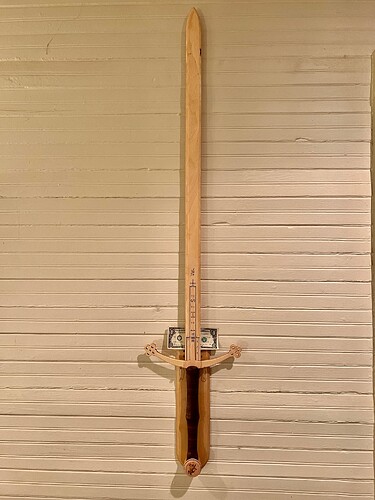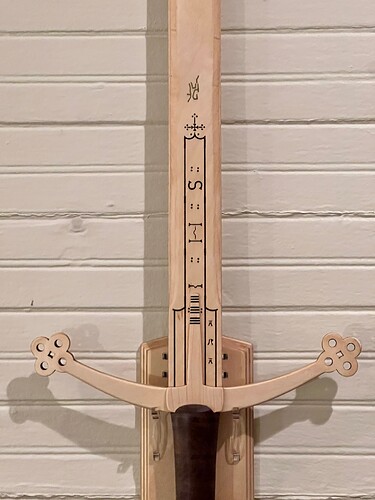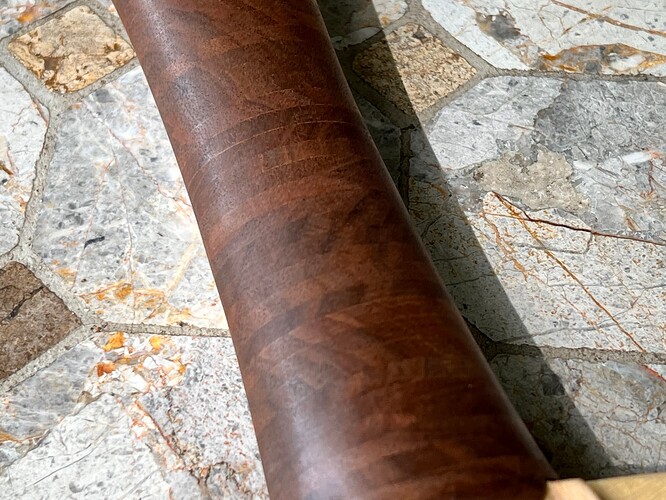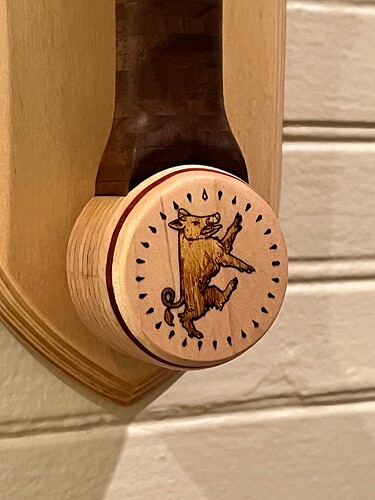I was commissioned by Glowforge to make a sword for their regular employee raffles. I was given carte blanche, just to make them a sword that I thought was worthy. I looked at my sword projects and decided that revisiting my old claymore design and customizing it for the occasion was just what was needed.
Here it is, dollar bill for scale. It’s big, roughly 53" (135cm) tip to pommel.
Baltic Birch plywood, Figured Black Walnut, Yellowheart, Redheart, Maple, 1/4" clear acrylic, Brass.
The sword dimensions are based on a 16th c./17th c. sword at the Metropolitan Museum of Art. You can view that sword here:
Some more pictures. The blade is engraved with the same design as the original, but as if the designer had modern tools: lines are straightened, symmetry is more exact, that sort of thing. The original has a stylized inlaid brass engraving whose meaning isn’t exactly known – possibly a horse. I inlaid powdered brass in the the blade to match it.
Baltic Birch plywood, Figured Black Walnut, 1/4" clear acrylic, Brass.
The handle is layered 1/8" walnut, sanded to a smooth finish and sealed with satin polyurethane. It’s very comfortable in the hand, and since it’s the way that people will interact with the sword it pays to take your time and get it exactly right.
Figured Black Walnut.
The Pommel designed is centered around the boar rampant, and is a signature – the boar is featured on the Evans family coat of arms. The boar itself is an inlaid engraved piece of yellowheart, the pommel main body is hard Maple, and the accent ring is redheart.
Baltic Birch plywood, Figured Black Walnut, Yellowheart, Redheart, Maple.
The wall mount is a similar design to my other claymore project. This one has the same boar motif engraved on the base and the small image of the sword serves as a sort of intuitive instruction as to how it should be hung. The mount is made of 1/8" layers but the edges were sanded down to make them a smooth surface, not stair-stepped. The wallmount rear face is engraved with a description of the design motifs in the project and some information about the historical sword at the Met, complete with a QR code to take you to the museum’s website (linked above). It also contains a message specifically for whomever wins the sword in the raffle, a bit of detail that is only for its bearer.
Baltic Birch plywood, 1/4" clear acrylic.
It’s always fun to make more swords, I appreciate Glowforge for being interested enough to want one for their raffle!
My other sword projects are here:
https://community.glowforge.com/tag/swords





